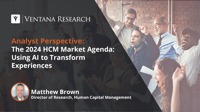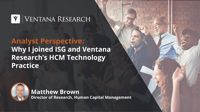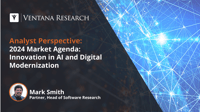I am happy to share insights gleaned from our latest Buyers Guide, an assessment of how well software providers’ offerings meet buyers’ requirements. The Learning Management Systems: Ventana Research Buyers Guide is the distillation of a year of market and product research by Ventana Research.
Read More
Topics:
Human Capital Management,
Learning Management
Today’s workforce places a high expectation on an enterprise’s commitment to fostering a fair and inclusive workplace. Numerous advances have been made in technology and employment regulations in the past few years, elevating the need and urgency for equitable and transparent operations relative to employee compensation. Technology plays a critical role in unlocking an enterprise’s ability to modernize its compensation practices and enact a system of processes designed to ensure a fair and...
Read More
Topics:
Human Capital Management,
Total Compensation Management,
employee experience
It has been a predominant buzzword for several years across all areas of human resources (HR), but artificial intelligence (AI) and learning and development (L&D) are finally beginning to integrate at scale, and it is one of the most transformative evolutions for the function of learning and development in the last 15 years. For a few years, we have been learning more about how AI will impact our daily personal lives, and more recently we have seen widespread evidence of how AI will impact our...
Read More
Topics:
Human Capital Management,
Learning Management,
employee experience
The importance of human resources technology in the workplace is growing at a phenomenal pace. While many HR applications like payroll, benefits management and human resource information systems have been perceived as critical, the new sense of criticality is more extensive than ever. HR technology is necessary to power the function of HR, but it also needs to serve as the leading example of how to engage, embrace and include all workers in the workplace experience and community. HR...
Read More
Topics:
Human Capital Management,
employee experience
I am happy to share insights gleaned from our latest Buyers Guide, an assessment of how well software providers’ offerings meet buyers’ requirements. The Ventana Research Workforce Management Suites Buyers Guide is the distillation of a year of market and product research by Ventana Research.
Read More
Topics:
Human Capital Management,
Workforce Management
The workforce of today has been very clear with their needs, wants and expectations. They need to feel seen, valued, heard, included and empowered. They want to work in an organization that feels like a community and aligns with their personal value systems. Importantly, they expect access to technology and to be developed and supported as they navigate their careers.
Read More
Topics:
Human Capital Management,
Learning Management
By the year 2025, the U.S. Department of Labor estimates that the generational makeup of our workforce will be:
Read More
Topics:
Human Capital Management,
employee experience
Ventana Research recently announced its 2024 Market Agenda for Human Capital Management, continuing the guidance we have offered for two decades to help enterprises derive maximum potential from workforce- and people-related technology investments and initiatives. In crafting this Market Agenda, we focused on essential themes that are critical for HR organizations and for the software providers supporting them. The transformative nature of AI has not just begun to bring intelligence to HCM; it...
Read More
Topics:
Human Capital Management,
Learning Management,
Talent Management,
Workforce Management,
Payroll Management,
Total Compensation Management,
employee experience
I am excited to announce that I have joined Ventana Research and ISG to lead coverage of the Human Capital Management technology practice, including Continuous Payroll, Employee Experience, Learning Management, Talent Management, Total Compensation Management and Workforce Management.
Read More
Topics:
Human Capital Management
Ventana Research has announced its market agenda for 2024, continuing a 20-year tradition of credibility and trust in our objective efforts to educate and guide the technology industry. Our research and insights are backed by our expertise and independence, and we do not share our Market Agenda or our market research, including analyst and market perspectives, with any external party before it is published. We continuously refine our Market Agenda throughout the year to ensure we offer the...
Read More
Topics:
Customer Experience,
Human Capital Management,
Marketing,
Office of Finance,
Digital Technology,
Operations & Supply Chain,
AI,
Digital Business,
Analytics & Data,
Office of Revenue



















